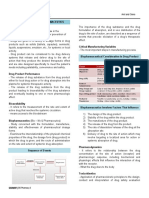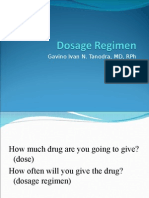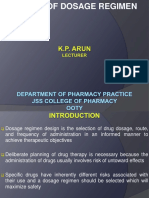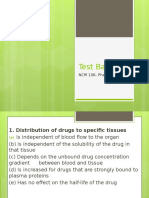Body Surface Area: Drug Dose (Drug Dose Ordered) X (BSA in M
Uploaded by
PewDiePie JuniorBody Surface Area: Drug Dose (Drug Dose Ordered) X (BSA in M
Uploaded by
PewDiePie JuniorBODY SURFACE AREA
Drug dose= (Drug dose ordered) X (BSA in m2)
BSA: determined by where the person’s height and weight interact in
the nomogram scale
Body Weight
Three steps:
Step One: convert pound to kilograms if necessary
Step two: determine the drug dose per body weight by
multiplying
Client’s dose per day = drug dose x body weight
Step three: follow with the basic formula or ratio and proportion
method to calculate drug dose
BODY SURFACE AREA
Drug dose= (Drug dose ordered) X (BSA in m2)
BSA: determined by where the person’s height and weight interact in
the nomogram scale
BODY WEIGHT
Three steps:
Step One: convert pound to kilograms if necessary
Step two: determine the drug dose per body weight by
multiplying
Client’s dose per day = drug dose x body weight
• Step three: follow with the basic formula or ratio and
proportion method to calculate drug dose
BASIC FORMULA
𝐷 (𝐷𝑒𝑠𝑖𝑟𝑒𝑑)
𝑥 𝑉 (𝑉𝑒ℎ𝑖𝑐𝑙𝑒) = 𝐴 (𝐴𝑚𝑜𝑢𝑛𝑡 𝑡𝑜 𝑔𝑖𝑣𝑒)
𝐻 (𝐻𝑎𝑣𝑒)
RATIO AND PROPORTION
Known Desire
𝐻 ∶ 𝑉 ∶: 𝐷 ∶ 𝑋
Means
Where: extremes
H= drug on hand (available)
V= vehicle or drug form
D= desired dose (as ordered)
X= unknown amount to give
:: = Stands for “as” or “equal to”
PEDIATRIC DRUG CALCULATIONS
Pediatric Dosage per Body weight: (follow basic
formula)
Pediatric Dosage per Body Surface Area –
(follow the same formula for BSA)
Pediatric Dosage from Adult Dosage
𝑆𝑢𝑟𝑓𝑎𝑐𝑒 𝑎𝑟𝑒𝑎 (𝑚2 )
𝑃𝑒𝑑𝑖𝑎𝑡𝑟𝑖𝑐 𝑑𝑜𝑠𝑎𝑔𝑒 = 𝑥 𝐴𝑑𝑢𝑙𝑡 𝐷𝑜𝑠𝑒
1.73 𝑚2
PEDIATRIC DRUG CALCULATIONS
FRIED’s RULE
′
𝑖𝑛𝑓𝑎𝑛𝑡 ′ 𝑠 𝑎𝑔𝑒 𝑖𝑛 𝑚𝑜𝑛𝑡ℎ𝑠
𝑐ℎ𝑖𝑙𝑑 𝑠 𝑑𝑜𝑠𝑒 = 𝑥 𝐴𝑑𝑢𝑙𝑡 𝑑𝑜𝑠
150
CLARK’S RULE
𝑤𝑒𝑖𝑔ℎ𝑡 (𝑙𝑏𝑠)
𝑐ℎ𝑖𝑙𝑑 ′ 𝑠 𝑑𝑜𝑠𝑒 = 𝑥 𝐴𝑑𝑢𝑙𝑡 𝑑𝑜𝑠𝑒
150
YOUNG’S RULE
𝑎𝑔𝑒 𝑜𝑓 𝑐ℎ𝑖𝑙𝑑
𝑐ℎ𝑖𝑙𝑑′ 𝑠 𝑑𝑜𝑠𝑒 = 𝑥 𝐴𝑑𝑢𝑙𝑡 𝑑𝑜𝑠𝑒
𝑎𝑔𝑒 𝑜𝑓 𝑐ℎ𝑖𝑙𝑑 + 2
PARENTERAL DOSAGE OF DRUGS
PREPARATION OF SOLUTIONS AND CALCULATIONS OF
DOSAGES EXPRESSED IN RATION AND PERCENT
𝑫 (𝒔𝒕𝒓𝒆𝒏𝒈𝒕𝒉 𝒐𝒇 𝒅𝒆𝒔𝒊𝒓𝒆𝒅 𝒔𝒐𝒍𝒖𝒕𝒊𝒐𝒏)
𝑨𝒎𝒐𝒖𝒏𝒕 𝒐𝒇 𝒔𝒐𝒍𝒖𝒕𝒆 = 𝒙 𝑸 (𝒒𝒖𝒂𝒍𝒊𝒕𝒚 𝒐𝒇 𝒅𝒆𝒔𝒊𝒓𝒆𝒅 𝒔𝒐𝒍𝒖𝒕𝒊𝒐𝒏)
𝑯 (𝒔𝒕𝒓𝒆𝒏𝒈𝒕𝒉 𝒐𝒇 𝒔𝒐𝒍𝒖𝒕𝒆 𝒐𝒏 𝒉𝒂𝒏𝒅)
CALCULATION OF IV FLUIDS
METHOD 1
𝑎𝑚𝑜𝑢𝑛𝑡 𝑜𝑓 𝑠𝑜𝑙𝑢𝑡𝑖𝑜𝑛
1. = 𝑚𝑙/ℎ𝑟
ℎ𝑜𝑢𝑟𝑠 𝑡𝑜 𝑎𝑑𝑚𝑖𝑛𝑖𝑠𝑡𝑒𝑟
𝑚𝑙
ℎ𝑜𝑢𝑟 𝑚𝑙
2. = 𝑚𝑖𝑛
60 𝑚𝑖𝑛
3. ml/ min x drops per ml of IV set = gtts/min
METHOD 2
𝑎𝑚𝑜𝑢𝑛𝑡 𝑜𝑓 𝑠𝑜𝑙𝑢𝑡𝑖𝑜𝑛
1. = 𝑚𝑙/ℎ𝑟
ℎ𝑜𝑢𝑟𝑠 𝑡𝑜 𝑎𝑑𝑚𝑖𝑛𝑖𝑠𝑡𝑒𝑟
𝑚𝑙
𝑥 𝑑𝑟𝑜𝑝𝑠 𝑝𝑒𝑟 𝑚𝑙 (𝐼𝑉 𝑠𝑒𝑡)
ℎ𝑟
2. = 𝑔𝑡𝑡𝑠/𝑚𝑖𝑛
60 𝑚𝑖𝑛𝑢𝑡𝑒𝑠
METHOD 3
𝑔𝑡𝑡𝑠
𝑎𝑚𝑜𝑢𝑛𝑡 𝑜𝑓 𝑓𝑙𝑢𝑖𝑑 𝑥 (𝐼𝑉 𝑠𝑒𝑡) 𝑔𝑡𝑡𝑠
𝑚𝑙
1. 𝑚𝑖𝑛 =
ℎ𝑜𝑢𝑟𝑠 𝑡𝑜 𝑎𝑑𝑚𝑖𝑛𝑖𝑠𝑡𝑒𝑟 𝑥 (60) 𝑚𝑖𝑛
ℎ𝑟
(Hourly Volume)
60𝑚𝑖𝑛
𝑑𝑟𝑜𝑝𝑠/ min 𝑥
ℎ𝑟 = 𝑚𝑙/ℎ𝑟
𝑑𝑟𝑜𝑝𝑠
𝑑𝑟𝑜𝑝 𝑓𝑎𝑐𝑡𝑜𝑟 ( )
𝑚𝑙
You might also like
- Bioavailability PK Practice Problems 2013No ratings yetBioavailability PK Practice Problems 20132 pages
- M2 - Lesson 1 - Preparation of Standard Patient ScriptingNo ratings yetM2 - Lesson 1 - Preparation of Standard Patient Scripting22 pages
- Drug Utilization Review: Worksheet ScoreNo ratings yetDrug Utilization Review: Worksheet Score30 pages
- Pharmacokinetics Review CEE With Practice Problems100% (1)Pharmacokinetics Review CEE With Practice Problems148 pages
- Biopharmaceutics: GSDMSFI - BS Pharmacy 3No ratings yetBiopharmaceutics: GSDMSFI - BS Pharmacy 311 pages
- Critical Evaluation of Biomedical LiteratureNo ratings yetCritical Evaluation of Biomedical Literature33 pages
- Application of Drug Information Retrieval and StorageNo ratings yetApplication of Drug Information Retrieval and Storage37 pages
- Medications & Calculations: 2. Apothecary 3. Household SystemNo ratings yetMedications & Calculations: 2. Apothecary 3. Household System8 pages
- Chapter 16 - Reducing and Enlarging Formulas Student100% (4)Chapter 16 - Reducing and Enlarging Formulas Student28 pages
- Drug Utilisation Evaluation: Keerthana.N 1 Year M.Pharm Dept. of Pharmacy Practice Grace College of PharmacyNo ratings yetDrug Utilisation Evaluation: Keerthana.N 1 Year M.Pharm Dept. of Pharmacy Practice Grace College of Pharmacy28 pages
- Pharmacy Patient Medication Profile Importance of Patient Medication ProfileNo ratings yetPharmacy Patient Medication Profile Importance of Patient Medication Profile12 pages
- Unit Vii: Prescription and Common AbbreviationsNo ratings yetUnit Vii: Prescription and Common Abbreviations30 pages
- 5.3 Clinical Pharmacokinetics and Pharmacotherapeutic Drug Monitoring (Theory)100% (1)5.3 Clinical Pharmacokinetics and Pharmacotherapeutic Drug Monitoring (Theory)1 page
- Chapter 3. One-Compartment Open Model Intravenous Bolus AdministrationNo ratings yetChapter 3. One-Compartment Open Model Intravenous Bolus Administration23 pages
- How The Body Affects The Drugs: College of Health SciencesNo ratings yetHow The Body Affects The Drugs: College of Health Sciences42 pages
- IP 155 Biopharmaceutics: Overview of The Course: Lecture Course ObjectivesNo ratings yetIP 155 Biopharmaceutics: Overview of The Course: Lecture Course Objectives42 pages
- The Ride of Your Life: What I Learned about God, Love, and Adventure by Teaching My Son to Ride a BikeFrom EverandThe Ride of Your Life: What I Learned about God, Love, and Adventure by Teaching My Son to Ride a BikeNo ratings yet
- Dose Calculation: Monika Jain, ICRI, IndiaNo ratings yetDose Calculation: Monika Jain, ICRI, India25 pages
- Physical Fitness: The Program Promotes Healthy Eating and Physical FitnessNo ratings yetPhysical Fitness: The Program Promotes Healthy Eating and Physical Fitness14 pages
- Rapid Microbiological Methods They Are Rapid Are They FastNo ratings yetRapid Microbiological Methods They Are Rapid Are They Fast9 pages
- Off label use of drugs assignment - Regulatory AffairsNo ratings yetOff label use of drugs assignment - Regulatory Affairs21 pages
- Mathematical Models Used in The Drug Release Studies100% (12)Mathematical Models Used in The Drug Release Studies27 pages
- Seminar On Protein and Peptides Drug DeliveryNo ratings yetSeminar On Protein and Peptides Drug Delivery37 pages
- Landaleos Introduction To Pharmacological TerminologyNo ratings yetLandaleos Introduction To Pharmacological Terminology96 pages
- A Glossary of Tibetan Medicinal Plants MMolvray100% (1)A Glossary of Tibetan Medicinal Plants MMolvray89 pages
- Pharmacy-Law-Ethics-CH-13-Good-Regulatory-Practices-NotesNo ratings yetPharmacy-Law-Ethics-CH-13-Good-Regulatory-Practices-Notes9 pages
- Scally - Anabolic Steroids - A Question of Muscle PDF100% (2)Scally - Anabolic Steroids - A Question of Muscle PDF253 pages
- 1 Social Administrative and Management Sciences Q&A Content Ver1100% (1)1 Social Administrative and Management Sciences Q&A Content Ver134 pages
- Chapter 18 Defense Mechanisms of The BodyNo ratings yetChapter 18 Defense Mechanisms of The Body3 pages
- Research Methodology and Medical Statistics-Book Preview29% (7)Research Methodology and Medical Statistics-Book Preview18 pages
- Manajemen Dan Penggunaan Obat (MPO) : DR - Dr.sutoto, M.Kes Komisi Akreditasi Rumah SakitNo ratings yetManajemen Dan Penggunaan Obat (MPO) : DR - Dr.sutoto, M.Kes Komisi Akreditasi Rumah Sakit88 pages
- Tips For Safe Medication Administration at HomeNo ratings yetTips For Safe Medication Administration at Home5 pages
































































































